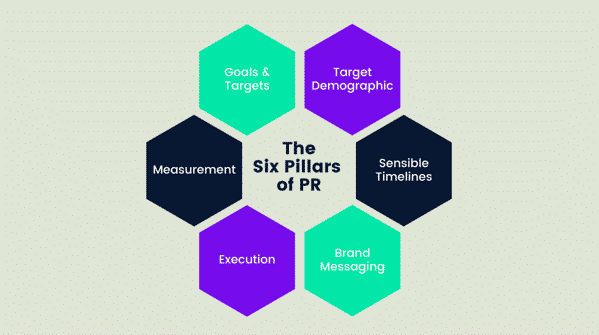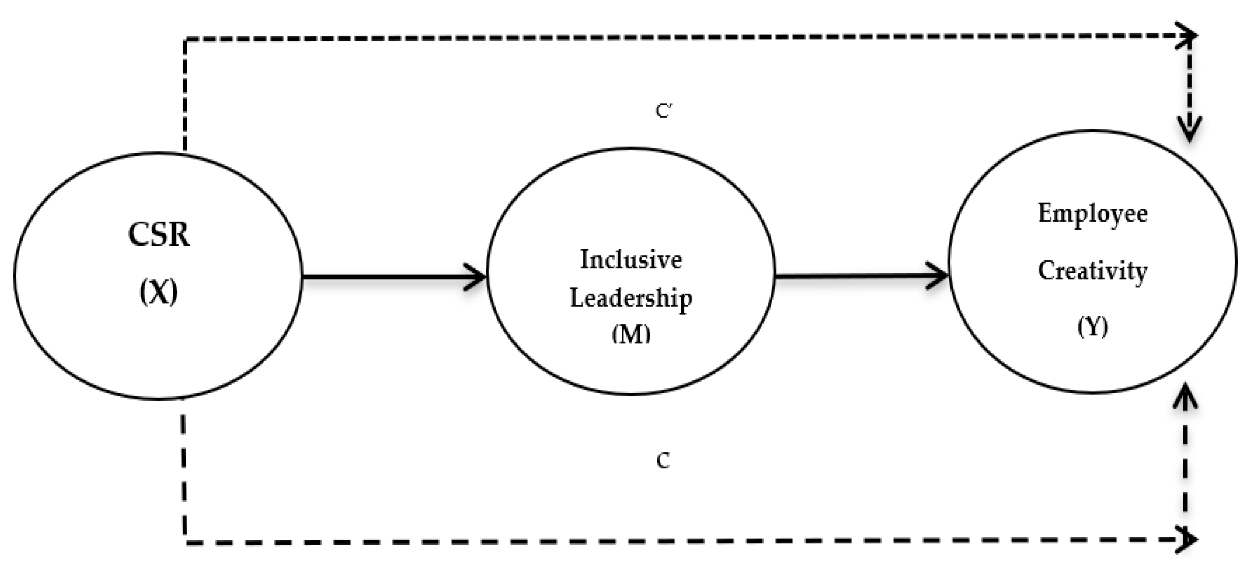Introduction
The study’s overarching goal was to provide a new theoretical framework for inclusive leadership to improve our understanding of its meaning and function in promoting gender equality and empowerment in public relations management. The essay proposed a theoretical model of inclusive leadership and discussed how inclusive leaders promote a diverse work environment and encourage women in public relations to take on leadership positions. In addition, the findings corroborated that inclusive leadership might have direct and indirect effects on women’s views of their potential for professional advancement. Through an inclusive leadership perspective, the article’s results suggested theoretical implications and actionable solutions to the problems faced by women in leadership roles. Figure 1 below shows the six pillars of public relations.

Discussion
According to the article’s review, there has been substantial literature on leadership research focusing on inclusive leadership to address leaders’ and organizations’ efforts to increase access to opportunities for underrepresented and marginalized groups and support diversity management efforts (Neill & Meng, 2021). Research focusing on testing and constructing inclusive leadership models in public affairs has not been investigated systematically or tested, despite the article’s recognition of the significance of hiring and empowering individuals from a wide range of backgrounds and disadvantaged minorities could assist the company in creating a healthier work environment. Following the call that inclusive leadership is both learnable and developable, the article suggests that the greatest need in today’s multicultural working environment in public relations is to ascertain the integral role of shared leadership in supporting women and racial minorities in the practice of public relations. A good example of a PR campaign encompassing these interests is Dove #TheSelfieTalk Campaign. Dove’s current social PR campaign, #TheSelfieTalk, keeps true to the company’s identity as a pioneer in body acceptance for women. This initiative is a part of the bigger #NoDigitalDistortion effort to combat negative portrayals of the female body in the media and reach young women and girls.

In keeping with the topic of this issue, the essay proposes a novel theoretical framework for understanding how inclusive leadership affects the sense of empowerment and advancement chances among women working in public relations. The article focused on how inclusive leadership might improve women’s perceptions of their career prospects directly and indirectly (Place & Vardeman-Winter, 2018). To start, the paper established the beneficial impact of inclusive leadership on the career development possibilities of female professionals by validating their expectations for future professional success. The figure below shows the inter-relationship between CSR, customer relationship, and employee creativity.

The effects of inclusive leadership on the diverse atmosphere and the application of participative leadership inside a company were also investigated in this research. Based on the data presented in the article, it seems that a combination of leader inclusivity, a diverse organizational atmosphere, and the practice of participatory leadership may have a substantial, beneficial effect on women’s career advancement via their sense of empowerment. This research fills a gap in the literature by providing theoretical and practical implications for the role of inclusive leadership theory in promoting DEI management in public relations.
Our results add to the research on women in leadership positions in public affairs by showing how leader inclusivity is crucial to allowing women in the field to fully realize their potential as strong, independent leaders at every stage of their careers. It is crucial for public affairs scholars to acknowledge the potential charitable donations of inclusive governance conceptual framework to gender and diversity research in public relations, despite criticism that the scholarly charitable donations to the inclusive leadership literature have different definitions of the inclusiveness construct.
Through an analysis of the relationships between leader inclusiveness, organizational diversity climate, and participative leadership, our study also shows the significance of situating strong leadership within the larger context of the organizational environment. Our findings provide a novel approach to highlighting the importance of adopting employee participation within the inclusion framework, despite the long history of researching inclusive leadership in combination with various antecedent circumstances. Therefore, the formation of inclusive leadership may make it feasible and successful for companies to implement participatory leadership policies and practices and create a diverse atmosphere. In addition, the data associated with these enabling institutional variables helps to construct a unified understanding of employee empowerment and its effects on women’s senses of empowerment and development prospects. So far, studies on inclusive leadership’s effects have mostly looked at them from a relational or leader-follower viewpoint. More subsequent studies have examined the correlation between inclusive leadership and other aspects of business success.
Public relations theorists can learn from existing literature on inclusive leadership by developing a novel theoretical framework that considers the positive contributions that diversity can make to the field. The robust affecting process that employee engagement can insert reduces disparities and workplace discrimination and the positive message it can foster to replace unwelcome policies and systems (Madden & Levenshus, 2021). Finally, by taking into account various organizational environment characteristics, this research offers a more nuanced understanding of inclusive leadership’s impact. This instance proves that inclusive leadership must place a premium on each department’s responsibility for and contribution to the organization’s success.
Implications
This article’s results imply that there are definite, observable advantages for leaders at all levels of an organization when those leaders exhibit inclusive leadership practices and competencies. Inclusive leadership significantly benefits a company’s stance toward diversity, equity, and inclusion efforts. As such, it strongly recommends that the organization openly welcome and encourage participation from disadvantaged minorities in its decision-making processes. As a leadership style that is potent and favorable to inviting discussion, showing availability, and demonstrating availability, inclusive leadership is displayed individually to assist female workers in public relations in feeling empowered. Figure 3 below shows how public relation campaigns are conducted.

The implications of the research extend beyond those for women working in public relations. It is not only women who may profit from leaders who actively attempt to include and support their members; other underrepresented groups and ethnic minorities can also reap the same rewards (Krugler, 2018). The leaders of an organization and the underrepresented groups need to have open lines of communication to guarantee that the inclusive language used by the leaders reflects the actions taken by the organization. Learning and practicing inclusive leadership may help leaders better connect with their teams and inspire greater loyalty and trust among their followers, as revealed by Choi & Mai-Dalton (2017). This research suggests that learning and practicing inclusive leadership may aid leaders. The empowerment thesis in public relations proposes that a practice that serves the interests and concerns of a large number of people may have positive effects on society if inclusive leadership is jointly supported by a publicly recognized diverse atmosphere and continuously reinforced participatory leadership. In other words, the empowerment thesis suggests that a practice that serves the interests and concerns of many people may positively affect society.
Recommendations
Human resources should work more closely with managers and help them acquire the knowledge, attitudes, and practices needed to actualize all-inclusive leadership aspects fully. The desired levels may describe how each dimension should be exercised. For managers to back women’s efforts in the workplace (in positions of organizational leadership), they need to have a firm grasp of what those efforts include and why they are essential. Therefore, HR professionals should work closely with managers, sharing information, including the need for inclusion-related initiatives, the aims of such efforts, and how leaders may contribute. Therefore, it is essential to encourage managers to develop the appropriate habits to boost their participation in important HR activities, such as encouraging a diverse applicant pool during the recruiting phase.
Our second recommendation is that businesses institute some feedback mechanism via which supervisors may talk to one another and exchange stories of how they have successfully implemented inclusive leadership. For instance, supervisors may provide input on how and whether their workers perceive gratitude expressions and whether or not such expressions are received similarly. Such knowledge may help businesses design more nuanced incentive programs that meet the needs of a more diverse workforce.
Limitations
Nonetheless, this article does provide a solid theoretical and empirical foundation for comprehending the role of shared leadership in continuing to support women in public relations in empowering and advancing to leadership positions. Although the assessment in the article is not without constraints that should be taken into account by future studies, it does provide a solid theoretical and empirical foundation. The research authors acknowledge that to assess the assumptions based on the respondents’ responses, self-reported measures from a panel consisting only of women are necessary.
The article acknowledges that the findings may not apply to the public relations industry as a whole, as they were conducted as part of research focusing on women in leadership roles. In future research, the theoretical framework of inclusive leadership should be expanded beyond its current focus on women in corporate communications. Instead, increasing the samples’ diversity is crucial by including more members of historically underrepresented and underprivileged communities (Bardhan & Gower, 2022). Extending the article’s knowledge of the impact of shared leadership in a fast-evolving and multicultural work environment in public affairs requires more study to evaluate other possible effects.
Conclusion
The research presented in this article represents a significant advance in developing theory in public relations research. It does this by highlighting the significant impact of inclusive leadership on the corporate surroundings and discovering how it may affect women in public alliances to achieve transformation and career progression. The purpose of this article is to encourage more research in the fields of inclusive leadership and gender studies in public relations so that these topics may be understood better.
References
Meng, J., & Neill, M. S. (2021). Inclusive leadership and women in public relations: Defining the meaning, functions, and relationships. Journal of Public Relations Research, 33(3), 150-167
Bardhan, N., & Gower, K. (2022). The role of leadership in building inclusive diversity in public relations. New York: Taylor & Francis.
Krugler, E. (2018). Women in public relations: The influence of gender on women leaders in public relations [Ph.D.]. Iowa State University, USA.
Madden, S., & Levenshus, A. (2021). Broadening the umbrella of women’s leadership and public relations: An ethnographic case study of a women’s political leadership development program. Journal of Public Relations Research, 33(3), 168-184.
Neill, M. S., & Meng, J. (2021). Women in public relations: Ascribed and avowed leadership identities and expectations. Journal of Public Relations Research, 33(3), 136-149.
Place, K. R., & Vardeman-Winter, J. (2018). Where are the women? An examination of research on women and leadership in public relations. Public Relations Review, 44(1), 165-173.
Choi, Y., & Mai-Dalton, R. R. (2017). On the leadership function of self-sacrifice. The Leadership Quarterly, 9(4), 475–501.